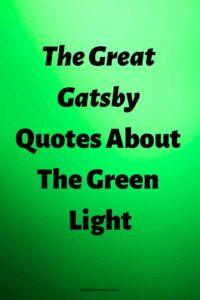What does the distant green light truly represent in F. Scott Fitzgerald’s The Great Gatsby?
This tiny, elusive beacon across the bay becomes the novel’s most potent and enduring symbol.
These 7 The Great Gatsby quotes about the green light with page numbers (from the Scribner 2020 ed.) analyze the layers of meaning of this iconic image.
Initially appearing as the object of Jay Gatsby’s mysterious longing, the green light evolves to encompass themes of hope, the unattainable past, the allure and illusion of the American Dream, and human desire.
The Distant Beacon: Introducing the Green Light
Fitzgerald subtly introduces the green light near the end of the first chapter, immediately linking it to Gatsby’s enigmatic character and the vast emotional distance he seeks to bridge.
“…he stretched out his arms toward the dark water in a curious way, and, far as I was from him, I could have sworn he was trembling. Involuntarily I glanced seaward — and distinguished nothing except a single green light, minute and far away, that might have been the end of a dock.”
(Speaker: Nick Carraway as narrator observing Jay Gatsby, Chapter 1, Pages 20-21)
This foundational image establishes the green light’s symbolic weight. Gatsby’s trembling reach across the dark water toward a “minute and far away” light physically manifests his intense yearning for something distant, linking the beacon immediately to deep, almost painful desire.
The light’s meaning shifts once Gatsby is close to Daisy. It transforms from a powerful symbol of hope into an ordinary object, its magic diminished by reality.
Symbol Unveiled: Daisy, Hope, and the Diminished Light
When Gatsby finally reunites with Daisy, the green light, once a symbol of almost mystical significance, loses its enchantment, demonstrating the gap between idealized desire and tangible reality.
“‘If it wasn’t for the mist we could see your home across the bay,’ said Gatsby. ‘You always have a green light that burns all night at the end of your dock.’”
(Speaker: Jay Gatsby to Daisy Buchanan, Chapter 5, Page 92)
Gatsby explicitly identifies the light with Daisy’s home, confirming it as the fixed point of his long vigil. Stating “You always have…” reveals that the light is his constant, unwavering symbol of hope and Daisy’s presence across the bay.
“Possibly it had occurred to him that the colossal significance of that light had now vanished forever. Compared to the great distance that had separated him from Daisy it had seemed very near to her, almost touching her. It had seemed as close as a star to the moon. Now it was again a green light on a dock. His count of enchanted objects had diminished by one.”
(Speaker: Nick Carraway reflecting on Jay Gatsby and the green light, Chapter 5, Page 93)
With Daisy physically present, the light’s “colossal significance” evaporates. Nick observes its demotion from a near-mythical symbol (“close as a star to the moon”) to a mundane object (“again a green light on a dock”), illustrating how reality inevitably diminishes the power of idealized dreams.
In the novel’s closing thoughts, Nick elevates the green light beyond Gatsby’s obsession, transforming it into a universal symbol for the ceaseless human pursuit of an idealized future.
The Enduring Symbol: The Dream, the Past, and the Future
Nick Carraway’s final reflections universalize the green light, connecting Gatsby’s specific longing to the broader American experience of striving for a future that remains perpetually out of reach, forever tied to the past.
“And as I sat there brooding on the old, unknown world, I thought of Gatsby’s wonder when he first picked out the green light at the end of Daisy’s dock. He had come a long way to this blue lawn and his dream must have seemed so close that he could hardly fail to grasp it. He did not know that it was already behind him, somewhere back in that vast obscurity beyond the city, where the dark fields of the republic rolled on under the night.”
(Speaker: Nick Carraway as narrator, Chapter 9, Page 180)
Contemplating the “old, unknown world,” Nick connects Gatsby’s pursuit of the light to the foundational American impulse. He grasps the inherent tragedy: the idealized future symbolized by the light (“his dream”) belonged to a moment already passed, making Gatsby’s immense effort tragically wasted.
“Gatsby believed in the green light, the orgastic future that year by year recedes before us. It eluded us then, but that’s no matter – to-morrow we will run faster, stretch out our arms farther…”
(Speaker: Nick Carraway as narrator, Chapter 9, Page 180)
Nick explicitly broadens the symbol, linking Gatsby’s belief in the green light to the universal hope in an “orgastic future.” This future, synonymous with the American Dream, perpetually “recedes,” yet inspires relentless striving (“run faster, stretch out our arms farther”).
“So we beat on, boats against the current, borne back ceaselessly into the past.”
(Speaker: Nick Carraway as narrator, Chapter 9, Page 180)
The novel’s resonant conclusion links directly to the green light’s representation of that receding future. Our determined struggle forward (“beat on”) is constantly fought against the powerful “current” of the past, framing the pursuit of the dream (the light) as a perpetual, yearning human condition.
 The green light: Symbol of Gatsby’s longing.
The green light: Symbol of Gatsby’s longing.
The Unreachable Light
The green light flickers at the heart of The Great Gatsby, radiating layers of meaning. It begins as Jay Gatsby’s intensely personal symbol of hope, a beacon representing Daisy Buchanan and the idealized past he yearns to recapture.
Yet, through Fitzgerald’s artistry, this simple dock light becomes a profound metaphor for the American Dream. As these defining quotes show, it embodies the intoxicating allure of an idealized future, the painful reality of its unattainability, and the inescapable currents of the past that shape all human striving.
Explore the rich symbolism woven throughout Fitzgerald’s masterpiece: discover 83 unforgettable quotes capturing The Great Gatsby’s essence.
A Note on Page Numbers & Edition:
Like the elusive green light across the bay, page numbers for The Great Gatsby can differ across editions! We referenced these page numbers from the authoritative The Great Gatsby: The Only Authorized Edition (Scribner, November 17, 2020), ISBN-13: 978-1982149482. Always consult your specific copy to ensure accuracy.
